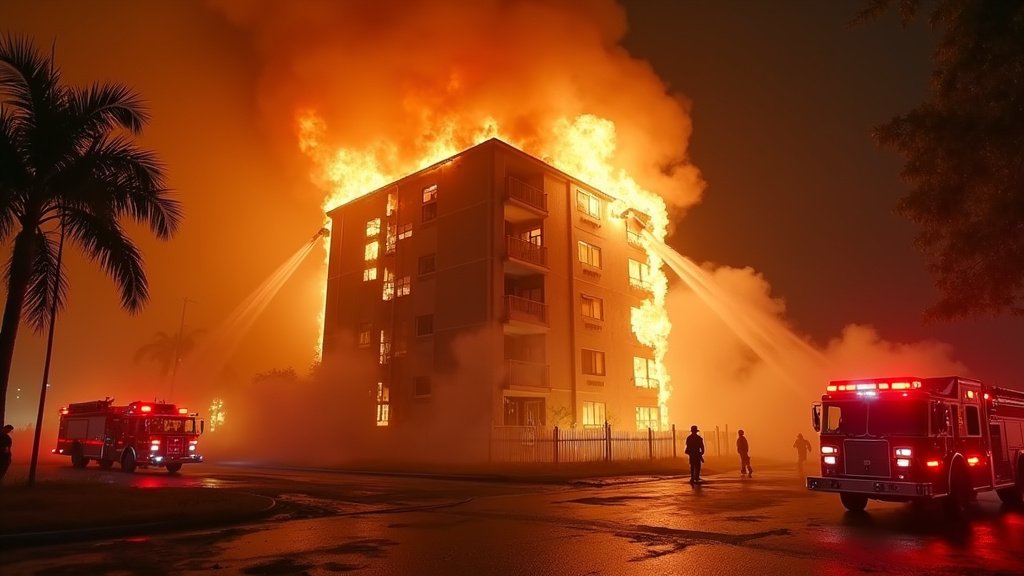MIAMI-DADE COUNTY, Fla. – Firefighters from Miami-Dade Fire Rescue successfully brought a significant blaze under control at an abandoned apartment building in southwest Miami-Dade early Sunday morning. The fire, located on the 26300 block of Southwest 139th Avenue, required a substantial response, escalating from an initial first alarm to a defensive second alarm due to the intensity of the smoke and flames.
Crews arrived to find heavy fire conditions engulfing the structure. The decision to adopt a defensive strategy meant firefighters focused on containing the blaze from the exterior, a critical measure when dealing with abandoned buildings where structural integrity is often compromised and the risk of collapse is high. Thankfully, Miami-Dade Fire Rescue reported that no injuries were sustained by civilians or fire personnel during the incident. An investigation into the exact cause of the fire has been initiated.
Battling a Familiar Threat: Abandoned Structure Fires in Miami
Fires in abandoned buildings represent a persistent and dangerous challenge for fire departments across South Florida, and Miami-Dade is no exception. These structures, often left unsecured and neglected, can become magnets for illegal activity and pose significant safety risks. Past incidents in the region highlight the recurring nature of this problem. In July 2025, an abandoned home in Miami was destroyed by fire, with neighbors suggesting squatters may have been involved. Earlier in May 2025, an abandoned warehouse in Miami erupted in massive flames, leading to a firefighter being hospitalized for heat exhaustion and a back injury, underscoring the inherent dangers.
In March 2023, City of Miami firefighters spent hours battling a blaze at another abandoned apartment building in a densely packed Little Havana neighborhood, a situation that necessitated aggressive exterior attacks and evacuations of nearby residences due to exposure risks. These events, along with others involving vacant homes and warehouses, illustrate a broader trend where neglected properties become sites of destructive fires. The lack of oversight, coupled with the potential for arson or accidental ignitions from transient occupants, makes these buildings ticking time bombs.
The Challenge of Blight and Vacant Properties
The fire at Southwest 139th Avenue also brings into sharp focus the ongoing issue of vacant and abandoned properties plaguing communities within Miami-Dade County and the wider Miami metropolitan area. These derelict structures contribute to urban blight, detract from neighborhood aesthetics and property values, and can create environments conducive to crime and further decay. Both Miami-Dade County and the City of Miami have implemented measures to combat this problem.
Miami-Dade County’s regulations mandate that owners of vacant structures must secure them at all times to safeguard public health and safety, preventing unauthorized entry and mitigating hazards. The County aims to ensure that these properties are maintained in good repair and do not pose risks to the community. Similarly, the City of Miami has ordinances in place that declare vacant, blighted, or unsecured structures a public nuisance. These codes establish responsibilities for property owners, often requiring registration of vacant properties and imposing penalties for non-compliance, seeking to reduce the burden on municipal services and neighborhoods. Such legislative efforts are often spurred by events like the one that occurred this past Sunday, prompting critical editorial discussions about urban planning, property maintenance, and the effectiveness of enforcement.
Miami-Dade Fire Rescue’s Role and Capabilities
Miami-Dade Fire Rescue (MDFR) plays a crucial role in responding to these emergencies and managing the associated risks. The department’s mission is to protect lives and property through proactive and responsive emergency services. Fighting fires in abandoned buildings presents unique challenges. Firefighters must contend with potentially unstable structures, hazardous materials that may have accumulated, and the difficulty of gaining entry and ventilation compared to occupied buildings. MDFR’s utilization of defensive tactics, as seen in the recent Southwest 139th Avenue incident, is a testament to their strategic approach to minimizing risk to their personnel.
Furthermore, MDFR actively engages in training programs to enhance the skills of its firefighters. The Acquired Structures Program, for instance, allows the department to use structures scheduled for demolition for realistic training exercises. This initiative improves performance in critical areas like search and rescue, forcible entry, and incident command, ultimately better preparing crews for complex fires, including those in abandoned buildings.
Community Impact and Future Outlook
While the immediate threat of the fire was contained, the incident serves as a stark reminder of the dangers posed by neglected properties. The plumes of smoke visible from a distance underscore the potential impact on nearby communities, even when direct property damage to occupied structures is avoided. Local news outlets frequently report on these incidents, reflecting the community’s concern and the ongoing need for effective solutions to address urban blight.
The investigation into the cause of the fire at the abandoned apartment building on Southwest 139th Avenue is ongoing. As authorities work to determine how the blaze started, the event reinforces the critical importance of property owner accountability and robust municipal oversight in managing vacant and abandoned structures. The recurring nature of these fires in Miami-Dade County underscores that the challenge of blight is far from over, requiring continuous vigilance and proactive strategies from both public entities and private property owners to ensure community safety and well-being.





